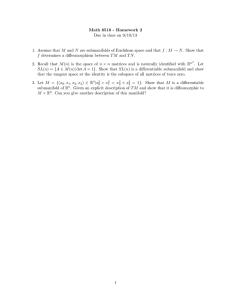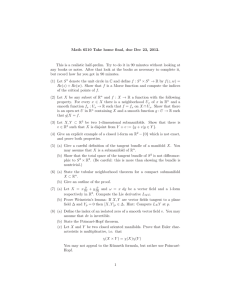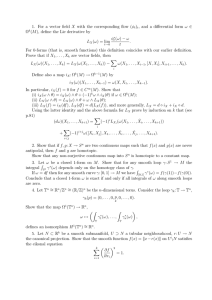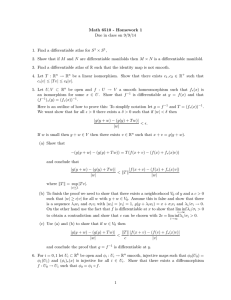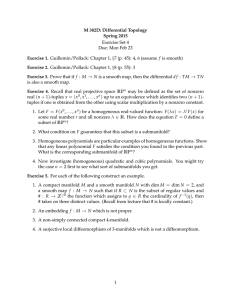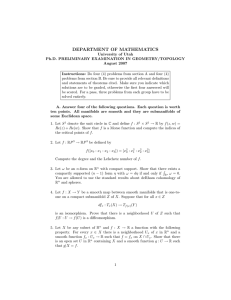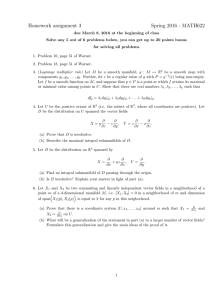M 382D: Differential Topology Spring 2015 Midterm Due: Mon Mar 30
advertisement
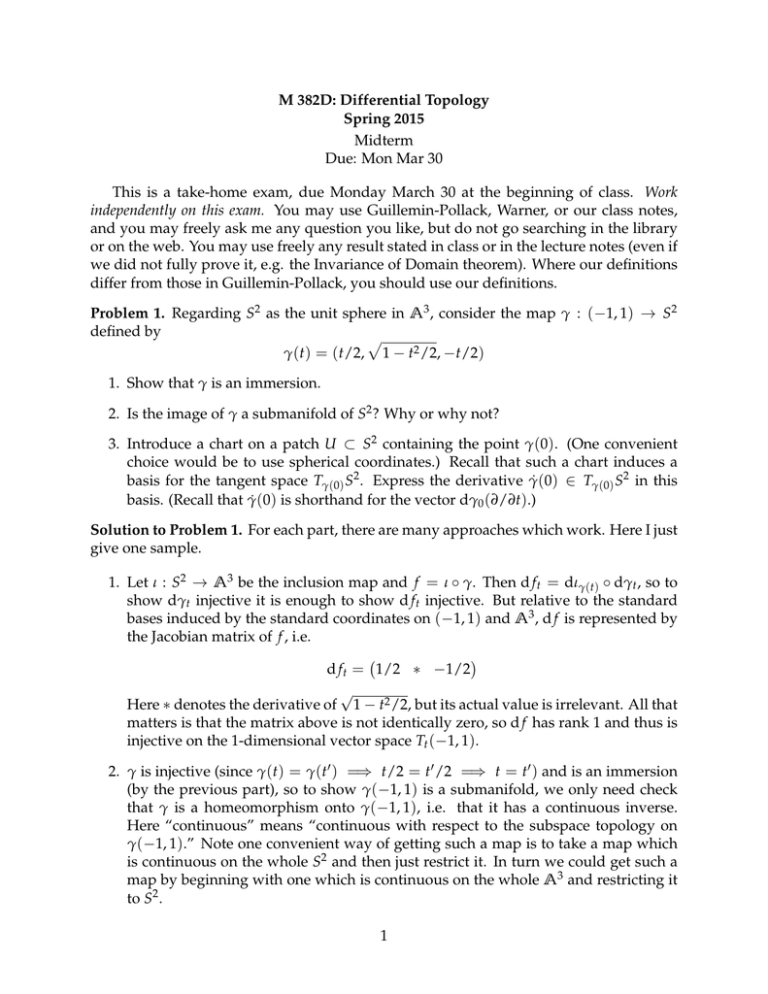
M 382D: Differential Topology
Spring 2015
Midterm
Due: Mon Mar 30
This is a take-home exam, due Monday March 30 at the beginning of class. Work
independently on this exam. You may use Guillemin-Pollack, Warner, or our class notes,
and you may freely ask me any question you like, but do not go searching in the library
or on the web. You may use freely any result stated in class or in the lecture notes (even if
we did not fully prove it, e.g. the Invariance of Domain theorem). Where our definitions
differ from those in Guillemin-Pollack, you should use our definitions.
Problem 1. Regarding S2 as the unit sphere in A3 , consider the map γ : (−1, 1) → S2
defined by
p
γ(t) = (t/2, 1 − t2 /2, −t/2)
1. Show that γ is an immersion.
2. Is the image of γ a submanifold of S2 ? Why or why not?
3. Introduce a chart on a patch U ⊂ S2 containing the point γ(0). (One convenient
choice would be to use spherical coordinates.) Recall that such a chart induces a
basis for the tangent space Tγ(0) S2 . Express the derivative γ̇(0) ∈ Tγ(0) S2 in this
basis. (Recall that γ̇(0) is shorthand for the vector dγ0 (∂/∂t).)
Solution to Problem 1. For each part, there are many approaches which work. Here I just
give one sample.
1. Let ι : S2 → A3 be the inclusion map and f = ι ◦ γ. Then d f t = dι γ(t) ◦ dγt , so to
show dγt injective it is enough to show d f t injective. But relative to the standard
bases induced by the standard coordinates on (−1, 1) and A3 , d f is represented by
the Jacobian matrix of f , i.e.
d f t = 1/2 ∗ −1/2
√
Here ∗ denotes the derivative of 1 − t2 /2, but its actual value is irrelevant. All that
matters is that the matrix above is not identically zero, so d f has rank 1 and thus is
injective on the 1-dimensional vector space Tt (−1, 1).
2. γ is injective (since γ(t) = γ(t0 ) =⇒ t/2 = t0 /2 =⇒ t = t0 ) and is an immersion
(by the previous part), so to show γ(−1, 1) is a submanifold, we only need check
that γ is a homeomorphism onto γ(−1, 1), i.e. that it has a continuous inverse.
Here “continuous” means “continuous with respect to the subspace topology on
γ(−1, 1).” Note one convenient way of getting such a map is to take a map which
is continuous on the whole S2 and then just restrict it. In turn we could get such a
map by beginning with one which is continuous on the whole A3 and restricting it
to S2 .
1
So now finally consider
g : A3 → A1
given by
g( x, y, z) = 2x.
Then g(γ(t)) = t, so g gives the desired continuous inverse to γ.
3. Let’s choose the coordinates ( x, y, z) → ( x, z), which are good coordinates on the
locus {y > 0} ⊂ S2 . Relative to these coordinates γ(t) = (t/2, −t/2) and dγ is
represented by the Jacobian matrix (1/2, −1/2). Thus, dγ(∂/∂t) = 12 ∂/∂x − 12 ∂/∂z.
Problem 2. Prove or disprove:
1. Let f : M → N be a smooth map and q ∈ N. Then f −1 (q) is a submanifold of M.
2. Every smooth map S1 × RP3 → S7 is homotopic to a constant map.
3. Every smooth map RP4 → RP4 is homotopic to a constant map.
4. If M is a smooth manifold of dimension m, and k ≤ m, then there exists an embedding Rk ,→ M.
Solution to Problem 2.
1. False. e.g. take f : A2 → A1 given by f ( x, y) = xy; then f −1 (0) is the union of the
coordinate axes, which is not locally Euclidean around (0, 0), since any neighborhood of (0, 0) can be broken into four connected components upon removing one
point.
2. True. Since dim(S1 × RP3 ) = 4 < 7, Sard’s theorem implies the image of such a map
f misses at least one point p ∈ S7 . But there is a coordinate chart x : S7 \ { p} → A7
(by stereographic projection), which moreover is surjective onto A7 . Thus we can
homotope f to a constant map by
f t ( p) = x −1 ((1 − t) x ( p)).
3. False. The identity map has mod 2 degree 1, while the constant map has mod 2
degree 0, so the two cannot be homotopic.
4. True. Fix a coordinate chart (U, x ) on M. x (U ) is open in Am and thus contains some
open ball B ⊂ x (U ). On the other hand Am itself is diffeomorphic to the open unit
ball, say via the map x 7→ √ x 2 which has inverse x 7→ √ x 2 . Composing
1+k x k
1−k x k
this with a rescaling, we get a diffeomorphism from Am to B. Then composing with
the inclusion into x (U ) we get a map from Am to x (U ). Finally composing this
with x −1 we get a map from Am to M. All maps we used are embeddings, so their
composition is also an embedding as desired.
2
Problem 3. Let Q ⊂ A2 be the unit circle. Consider the map f : A2 \ {(0, 0)} → A2 given
by
!
y
x
,p
f ( x, y) = p
x 2 + y2
x 2 + y2
1. Prove that f is not transverse to Q.
2. Exhibit a smooth homotopy F : [0, 1] × A2 \ {(0, 0)} → A2 such that F0 = f and F1
is transverse to Q.
Solution to Problem 3.
1. There are many approaches here. Here is one slick one which avoids any computation: f actually maps all of A2 \ {(0, 0)} to Q, so f −1 ( Q) is a 2-manifold, but if it
were transverse to Q then f −1 ( Q) should have dimension 2 − 1 = 1.
2. Again there are many approaches. The simplest way is to arrange that F1 misses Q
completely, e.g. by taking
Ft ( x, y) = (1 − t) f ( x, y).
Problem 4. Suppose U ⊂ An is an open set and f : U → R a smooth function. Define the
graph of f as a subset of An+1 and prove that it is a submanifold.
Solution to Problem 4. The graph of f is defined as
Γ f = {( x, y) : x ∈ U, y ∈ R, f ( x ) = y} ⊂ An+1 .
Consider the function g : U × A1 → R given by
g( x, y) = f ( x ) − y.
g is a submersion because
dg = ∂1 f · · · ∂n f 1
with respect to the standard bases, and thus evidently has rank 1. Thus Γ f = g−1 (0)
is a submanifold of U × R. This is not quite what we wanted: we wanted Γ f to be a
submanifold of the bigger space An+1 .
But note the general fact: if M is a submanifold of a manifold V and V is an open
subset of a manifold N then M is also a submanifold of N. This is because the good charts
on V which exhibit M as a submanifold work equally well as charts on N.
Using this, finally Γ f is a submanifold of An+1 as desired.
Problem 5. Suppose f : Rn → Rn is a smooth map, n > 1. Let K ⊂ Rn be compact
and e > 0. Show that there exists a map g : Rn → Rn such that dgx 6= 0 for all x and
k f ( x ) − g( x )k < e for x ∈ K. Also show that this is false for n = 1. (Hint: let Mn
be the space of n × n matrices, and show that the map F : Rn × Mn → Mn given by
F ( x, A) = d f x + A is a submersion. Thus there exists some A so that 0 is a regular value
of FA . Use this fact to construct the desired g. Where is the hypothesis n > 1 used?) (This
is Exercise 8 on page 75 of Guillemin-Pollack.)
3
Solution to Problem 5. First the counterexample for n = 1: take f ( x ) = x2 , K = [−2, 2]
and e = 1. If | f ( x ) − g( x )| < 1 for all x ∈ [−2, 2] then in particular
g(−2) > 3,
g(0) < 1,
g (2) > 3
Thus by the Mean Value Theorem there exist some a ∈ (−2, 0) and b ∈ (0, 2) with g0 ( a) <
0 and g0 (b) > 0. Then by the Intermediate Value Theorem there must be some c ∈ ( a, b)
with g0 (c) = 0.
Now suppose n > 1. In this case consider F ( x, A) as given in the hint above. Fix any
linear coordinate system on Mn (say the one given by taking the n2 matrix entries in some
fixed order). Then relative to these coordinates we have
dF = ∗ 1n2 ×n2
and thus dF has rank n2 (full rank), thus F is a submersion. It follows (by our transversality statements) that, for almost every A, the map FA ( x ) = d f ( x ) + A is transverse to the
point 0 ∈ Mn . Fix one such A, with the additional property that k Ak < e/diam(K ). Then
every point in FA−1 (0) is a regular point of FA . But since n < n2 (using n > 1), FA cannot
have any regular points, thus FA−1 (0) = ∅.
Now consider the map
g( x ) = f ( x ) + Ax
which has
dg = d f + A = FA
By the above, we have dg−1 (0) = ∅; and
k g( x ) − f ( x )k = k FA x k ≤ k Akk x k ≤ e
as desired.
Problem 6. Suppose given M, N smooth manifolds, and a smooth map f : M → N.
Suppose q ∈ N is a regular value for f . Let P = f −1 (q) ⊂ M. Show that the normal
bundle NP is a trivial bundle over P. (Recall the slogan that “any submanifold P ⊂ M
is given locally by k independent equations”; this problem says that if P ⊂ M is given
globally by k independent equations, then NP is trivial.) (One might view this problem as
composed of two parts: one part is to give an isomorphism ( NP) p ' Rk for each p ∈ P,
the other is to show that these isomorphisms fit together into a bundle isomorphism, i.e.
to check that they vary smoothly with p. You need not write down every detail of the
smoothness but please do not ignore it completely!)
Solution to Problem 6. For any p ∈ P consider the map d f p : Tp M → Tq N. Since q is
a regular value this map is surjective; on the other hand we know that its kernel is Tp P.
ff : Tp M/Tp P → Tq N i.e.
Thus d f p descends to an isomorphism d
p
ff : Np P → Tq N
d
p
4
These fiberwise isomorphisms fit together into a single map
ff : NP → P × Tq N.
d
ff is smooth, so that it gives a bundle isomorphism. Informally
We need to check that d
speaking this smoothness follows from the fact that f p depends smoothly on p; below, we
will spell out all the details, just to be sure. Supposing for a moment that this has been
done, choose any basis in Tq N (once and for all, not depending on p); then we can identify
Tq N with Rk and thus obtain the desired bundle isomorphism NP → P × Rk , completing
the proof.
ff let us make some prelimNow the gory details of smoothness. To check smoothness of d
inary comments. In general, suppose we have two vector bundles A and A0 over a base
manifold P, and a map ψ : A → A0 which takes fibers to fibers linearly, i.e. it comes from
linear maps ψ p : A p → A0p for each p ∈ P. Then to check smoothness of ψ at a point p, we
fix local trivializations
φ 0 : A 0 |U → U × Rn
φ : A |U → U × Rn
and consider the map
φ 0 ◦ ψ ◦ φ −1 : U × Rn → U × Rn
Since the local trivializations φ, φ0 are diffeomorphisms, φ0 ◦ ψ ◦ φ−1 is smooth if and only
if ψ is. But since it takes fibers to fibers linearly, and the fibers are just Rn , this map is of
the form
φ0 ◦ ψ ◦ φ−1 ( p, v) = ( p, T ( p)v)
for a map T : U → GL(n). Thus finally ψ is smooth if and only if T is smooth.
ff , we need local trivializations of the two bundles NP and
To apply this to our map d
P × Tq N over P. For NP, first recall that in general, local trivializations of a quotient bundle E/F are obtained as follows: take a patch U on which there exists a basis {ei }i=1,...,m
of sections of E, such that {ei }i=k+1,...,m are a basis for F ⊂ E; then we get a map
φ : ( E/F )|U → U × Rk
by
"
φ
k
#
∑ ci ei ∈ (E/F) p
!
= p, (c1 , . . . , ck ) .
i =1
In our situation, we have the quotient bundle NP = TM| P /TP. Fix a point p ∈ P. Since
P is a submanifold there exists a chart (U, x ) on M, containing p, such that
x ( P ∩ U ) = x (U ) ∩ { x 1 = · · · = x k = 0 } .
This chart induces a local basis { ∂x∂ i }i=1,...,m of sections of TM, which we can restrict to
sections of TM | P ; the subset { ∂x∂ i }i=k+1,...,m give a local basis of sections of TP. So, the
5
above general story about quotient bundles now says we have a local trivialization of NP
given by
#
!
"
k
∂
1
k
i
∈
NP
=
p,
(
c
,
.
.
.
,
c
)
.
φ
c
p
∑ ∂xi
i =1
For P × Tq N we get a trivialization just by fixing a basis in the fixed vector space Tq N;
we’ll use the basis { ∂y∂ j }kj=1 induced by some chart (V, y) on N with q ∈ V, which gives
the trivialization
!
k
∂
φ0 ∑ bi i ∈ p × Tq N = ( p, (b1 , . . . , bk )).
i =1 ∂y
(In this way we could even give a global trivialization of P × Tq N, and this was useful
above; but in principle that fact does not matter at this precise moment, since right now
our interest is just in checking smoothness, which is a purely local question.)
ff relative to these trivializations. We write f : M → N
Now we want to compute d
concretely in terms of its component functions f j = y j ◦ f . Then we have
#!
!
"
k
k k
k
j
∂
∂
∂
i
i
i∂f
ff
d
=
d
f
=
(
p
)
.
c
c
c
p ∑
∑
∑ ∂xi
∑
p
i
i
j
∂x
∂x
∂y
i =1
i =1 j =1
i =1
Thus
ff ◦ φ−1 ( p, ~c) = ( p, T ( p)~c)
φ0 ◦ d
where T ( p) is the k × k matrix with entries
j
T ( p )i
∂fj
= i ( p)
∂x
ff follows from the fact that these depend smoothly on
So finally, the smoothness of d
p. In other words, it is just the smoothness of f , as we hoped.
Remark. We could also have further “rectified” the situation by taking distinguished
charts (U, x ) and (V, y), with p ∈ U and q ∈ V, such that y ◦ f ◦ x −1 is the standard
projection Rm → Rk on the first k coordinates. In this case we would just have f j = x j
j
above, and so the matrix T ( p)i would be the identity matrix, which of course is also
smooth as a function of p. (In a sense this approach would be more natural, since the way
we prove P is a submanifold in the first place is to use these adapted charts anyway; the
only reason I didn’t adopt this approach is that I wanted to see the Jacobian of f appear
ff comes from smoothness of f ”.)
explicitly, and to justify the slogan that “smoothness of d
6
